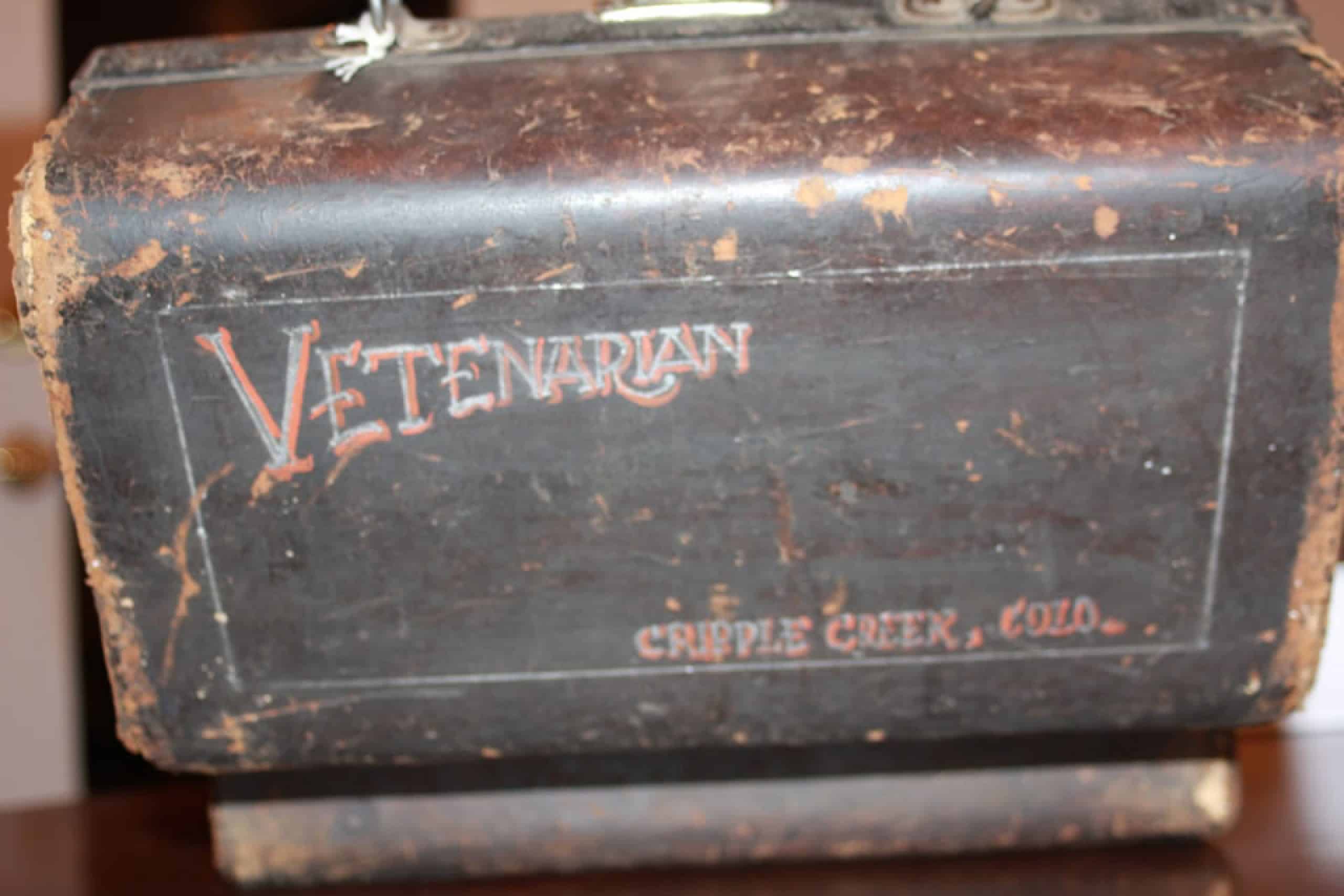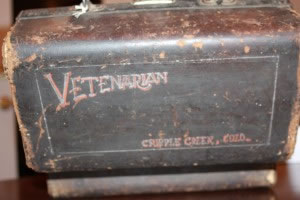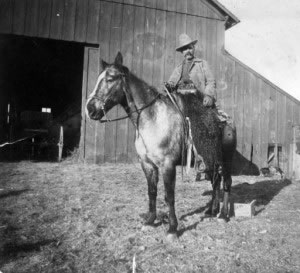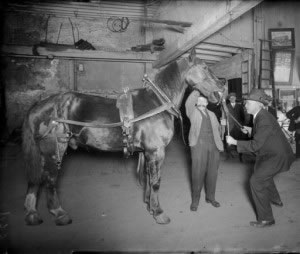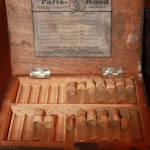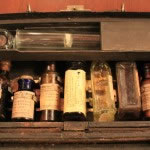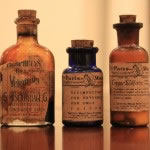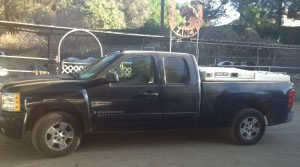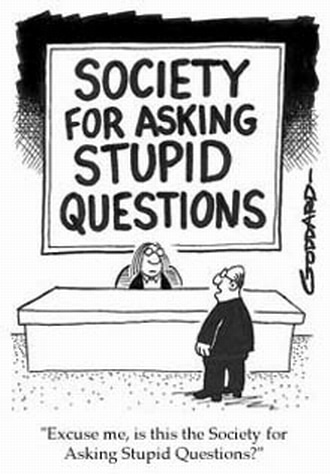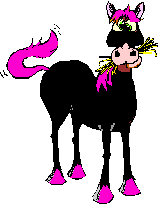A former mayor of the city of Harrisburg, PA, once decided that the city would be a great place to have a Wild West museum (check your maps, and see what you think). In fact, over about 15 years, the mayor accumulated enough stuff to populate about four museums. Unfortunately, the city went bankrupt, so, in 2013, they auctioned off their memorabilia. And among the many incredible items sold (a bowie knife belonging to the Wyatt Earp?) was a box carried by a veterinarian in Cripple Creek, Colorado. And I was lucky enough to win it.
SPELLING NOTE: Look at the box. Did someone change the spelling of “Veterinarian” in the last 100 years?
In the early 20th century, with over 10,000 residents, and with horses still being a primary engine of work and transportation, there was surely a need for someone to take care of the horses in Cripple Creek. I don’t know who he was, or where he was from. I do have a pretty good idea when the box was put together – it had to be around 1913 or 1914 based on the medications inside (more on that in a bit).
I have no idea who owned the box. The records of the Kansas Veterinary College show a 1911 graduate named Thomas Thornton Parker living in Cripple Creek during that time, but he was a “Superintendent of Manual Training.” Photographic records of the Denver Library show “Charley the Vet,” who lived well east of Cripple Creek in 1902, and the records indicate that he inspected horses that were being shipped to the Boer Wars, in South Africa. Charley got, “…his collar boan [sic] broke and 3 or 4 ribs caved in,” when working with a horse. He did come back to his ranch, but then he left. No one knows where he went. Maybe Cripple Creek?
I can’t imagine what it was like to have practiced in those days. I mean, this is before antibiotics, anti-inflammatory drugs, anesthetics, sedatives, and practical means of injecting medications (mass production of disposable syringes dates back to the mid-20th century – CLICK HERE to read about the history of the syringe and hypodermic needle). In sum, just about everything that makes veterinary medicine for horses today 1) somewhat safe, and 2) often effective, hadn’t even been invented when the veterinarian was using his box. To get some idea of what practice must have been like, take a look at this photo, from Denver, in the 1910’s – 1920’s, of a man – probably a veterinarian, pulling a horse’s tooth. Of course, I’ve extracted teeth before, but certainly not without sedation and/or restraint, and certainly not wearing a tie. Times change.
The box itself isn’t very big. It’s about 11 inches long, by 6 1/2 inches high, and six inches deep. It couldn’t have been very big, especially as it was most likely carried on horseback, or in a buggy or cart.
Inside the case is stamped “Paid, Sept. 2, 1890,” but I’m very confident that the medications in the box date from 1913 at the earliest. That’s because most of the medications in the box are from the Paris-Wood Drug Company of Colorado Springs, Colorado. According to the Southern Pharmaceutical Journal of March, 1913, WW Wood purchased an interest in the Paris Drug Company at that time.
The medications time stamp the box pretty specifically. By 1915, the Era Druggist’s Directory doesn’t list a Paris-Wood Drug company any more (there’ a Paris Company, and a Wood Company), and Mr. Wood opened a pharmacy in Oklahoma in 1915, while Mr. Paris moved to Texas in 1916. You can CLICK HERE to find out more about both Mr. Paris and Mr. Wood (thanks very much to pharmaceuticals collector Don Bergsengs for his help).
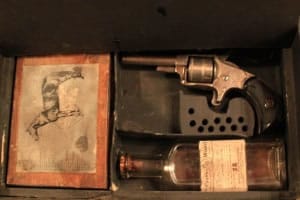 The case made of leather, and it’s divided into two sides.
The case made of leather, and it’s divided into two sides.
On one side of the box, there are only thee items. A pistol, a box of small, cork-stoppered vials, and a larger glass medicine bottle containing phenothizaine.
The pistol is clearly for protection of the veterinarian – the caliber of the gun is too small to put down a horse. The early 1900’s were wild times in Cripple Creek. Cripple Creek is a former gold mining camp located 44 miles southwest of Colorado Springs near the base of Pikes Peak. In 1890, it became the home of the last great gold rush in Colorado, after one of the largest gold strikes in history, the Independence Lode, was found. The population of the town went from a few hundred to over 10,000 in a short time. And, in the early 1900’s, it became the focus of the Colorado Labor Wars, a violent struggle over several years that cost many their lives. With all of that shooting going on, it’s no wonder that the veterinarian carried something for protection.
The wooden box with the little vials has a picture of a horse on it, with parts of the anatomy described. It’s a cool illustration, and the box is arguably even better. Honestly, I’ve never seen a medication box quite like it – it appears to have been some sort of package of medications – the vials aren’t labelled, so I have no idea what was in them. Maybe it was some sort of a prestocked package – I just don’t know.
What’s really interesting (to me, anyway) is that the medication bottle is of a medication called phenothiazine, and it’s labelled as a deworming product. While phenothiazine was first created in 1883, the sources that I’ve found say that it was first used as a dewormer on horses in the US in the 1940s (to lethal effect, unfortunately – CLICK HERE to read an article from 1942 about the drug in horses). Pretty clearly, at least based on this box, it was used a lot earlier than that. It’s been a pretty useful chemical – interestingly, today, phenothiazines are the largest class of human antipsychotic drugs. To see current recommendations about deworming your horse (you may be doing it too much – CLICK HERE).
The other side of the box contains several different medications, as well as a glass syringe. It wasn’t common to give horses intramuscular or intravenous injections of anything in the early part of the 20th century, and the bottles certainly did not contain sterile materials. The glass syringe would undoubtedly have been used for dosing.the medications, and I’d think that they must have been diluted in water, because each vial only holds about 10 or 20 milliliters of liquid.
What was the veterinarian interested in treating? Based on the bottles (there are 7 of them), pretty much the same stuff that we’re treating today.
1. WOUNDS – Three of the bottles are for things used to treat wounds. There’s a bottle of “Open Wound Soap Clean and Treat Solution,” a bottle of hydrogen peroxide solution, and a bottle of “Disinfectant for External Use Only.” Honestly, those things were probably all of some use (although I don’t recommend that you use hydrogen peroxide on your horse’s wounds). CLICK HERE to read my article, “Things to Put on Wounds.”
2. COLIC – There’s a bottle of “Colic Cure” for horses AND cattle. I figure it must not have been all that effective. It was probably injected rectally, with the glass syringe. Even though it probably didn’t do much, the majority of horses with colic get better on their own, so the medication probably would have seemed to be effective most of the time – just like happens today. And I’m also sure that , like today, a lot of things that are done for colicking horses don’t make any sense. CLICK HERE to read my article about “Colic Myths.”
3. LAMENESS REMEDY – There’s a vial of copper sulfate in the box. I find this REALLY interesting. The label directions say is should be applied under absorbent cotton after the blacksmith has pared away the foot. It’s a thrush remedy. And you know what? Copper sulfate is absolutely still used and recommended by some folks today!
4. MISCARRIAGE AND ABORTION REMEDY – The idea of “treating” abortion and miscarriage is a bit like closing the barn door after the horse has already run off. I mean, if you’re unfortunate enough to have had your mare abort, by all means call your veterinarian, because it’s important to make sure that your mare doesn’t have future problems as a result of her failure to carry her foal to term, but you can’t do anything about the miscarriage itself, so it’s hard to imagine 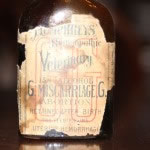 what a “remedy” for abortion might be.
what a “remedy” for abortion might be.
Still, it’s kind of interesting that this remedy is homeopathic. In fact, the remedy is from Humphrey’s Homeopathic, an extremely popular homeopathic remedy maker of the day. Humphrey’s was founded way back in 1853, and, believe it or not, the company is still in existence today. In the early 1900’s, homeopathic medicine was starting to lose popularity in the US, because the 18th century practice couldn’t compete with the scientifically-based medical schools and effective medicines that were starting to establish primacy in the medical field. You can CLICK HERE to read about Humphrey’s medications, and, if you want to learn more about homeopathy – which, honestly, is pretty silly, given what we have learned over the past 200+ years – CLICK HERE.
5. DEWORMING – Glover’s Vermifuge, for Dogs and Cats. This stuff must have been pretty popular, and there were probably plenty of dogs and cats around Cripple Creek. Dr. Henry Clay Glover started practicing veterinary medicine sometime before 1877, and by 1888, his medicines were awarded the medal of superiority by the American Institute of New York. He identified himself as a “Specialist in Canine Diseases.” Based in New York City, Dr. Glover produced the most extensive line of, for dog only, veterinary patent medicines in America. And if you’re REALLY interested, you can learn lots more about him if you CLICK HERE.
So, that’s it. Turns out that 100 years ago, a veterinarian in Colorado was worried about most of the same things that worry me now. His medications weren’t much – fortunately, horses tend to get better on their own from a lot of things. Even though I still take advantage of the horse’s body’s ability to heal, I’m glad that I have modern equipment and medicine at my disposal. Regardless, the box is a wonderful bit of history, and I’m glad I have it. I’m glad to have been able to share a little bit about it with you, as well.

